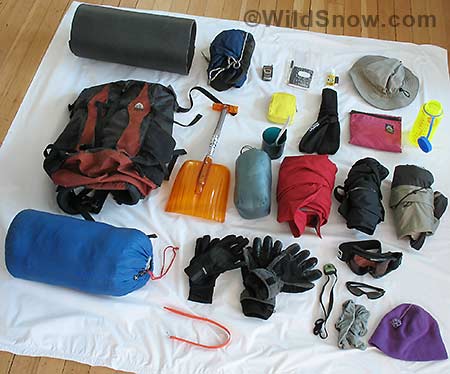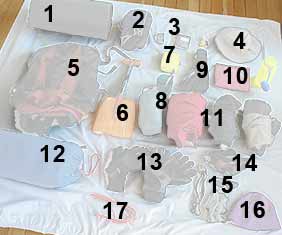Mission: Successful ski traversing without huts requires ultra-light equipment, as well as attention to the details of carrying and using functional equipment. Gear should be multi-purpose when possible. Avoid redundant choices (e.g., carrying a tent and a bivvy sack, or spare sunglasses as well as goggles). Try to reduce weight of each item. Shell pants are notoriously heavy (purchase lighter ones); portion out all consumables (tooth paste, sunscreen) so you carry only what you need for planned days out; watch weight of smaller items such as cups, spoons, gloves and hats; use only lightweight silnyl stuff sacks; use lithium batteries for all electronic devices (except beacons) and for spares.

Ski traverse overnight gear for backcountry skiing.

16 pound ski traverse pack contents key: (1)sleeping pad, (2)camp boots, (3)cell phone and notebook , (4)sun hat, (5)backpack, (6)small shovel, aluminum is best, (7)repair/first aid, (8)puff jacket and lexan cup/spoon, (9)sunscreen & socks, (10)toothbrush etc. and water bottle, poly bottle is lighter than lexan one shown, (11)soft shell and hard shell, (12)sleeping bag, (13)gloves, (14) sunglasses & goggles, (15)headlamp and balaclava, (16)ski cap, (17)ski strap
Total pack weight of the gear and clothing on this list, excluding skis/skins/boots, beacon, and the clothing you wear while climbing should be no more than 16 pounds, and you should be able to get it down to 15 pounds with careful gear selection. (Weigh pack with empty water bottle and no food, but include shell gear and extra clothing layers.)
Food weight is 1.5 lbs per day, which is totally adequate for up to four days or so; beyond that figure 2 lbs per day (body reserves are used up and caloric needs frequently increase).
Group gear (tents/stoves/fuel/rope) should add up to no more than 4 lbs per person. Goal of pack weight with food and group gear is maximum of 29 lbs (without water) for shorter ski traverses.
Externals and sleeping
– Rucksack (must weigh less than 5 pounds, but must have solid ski or snowboard lashing system and adequate volume, around 3,600 cubic inches.
– Ski poles (Any good quality alpine or backcountry skiing pole, use Whippets if steep hard snow is expected.)
– Skis with backcountry bindings (Use shorter/lighter ski models.)
– Ski lash strap (Long enough for multiple uses.)
– Climbing skins (With tail fix that’s tested and trouble free.)
– Ski crampons (Optional but usually carried.)
– Sleeping bag (Must be carefully chosen to work with clothing system so you can sleep warm on colder nights, down okay unless wet weather is expected, max weight should be about 3 1/2 pounds.)
– Sleeping pad (Low density foam such as Ridgerest are lightest weight, trim to narrower width.)
Clothing and worn
Altimeter/watch
Avalanche rescue beacon with fresh alkaline batteries
Super lightweight waterproof breathable shell pants (GoLite Shadow is good choice, see online store at bottom of page.)
Soft pants (Marmot ATV is a good medium weight choice.)
Ski boots (Fit with room for toes, use before trip to prevent blisters.)
Socks (No more than one pair spare socks, or just bring the ones on your feet.)
Long sleeved sun shirt, nylon or CoolMax, cotton if you must
Bill-cap with ear flaps, or larger brimmed “boonie” hat (Sun protection.)
Soft shell jacket (Look for simplicity.
Insulating layer such as fleece or puff jacket (Down or synthetic puff jacket.)
Hard shell jacket (Waterproof/breathable with hood, minimal design, if you carry a soft shell jacket make sure your hard shell is super light, should weigh no more than 12 ounces.)
Acrylic zip turtleneck long underwear top (Mountain Hardwear’s don’t stink.)
Mid-weight knit or fleece ski cap
Balaclava, lightweight (No need for this if your soft shell jacket has hood.)
Lightweight gloves (Thin, with palm wear protection, for skiing when warm.)
Ski gloves (High quality, waterproof breathable, not too heavy.)
Camp booties (Something to wear so you can get your feet out of your ski boots while cooking etcetera, a lightweight nylon “mukluk” that goes over your ski boot inners works well for this, is a tough item to find.)
The idea of the above clothing system is to use minimal upper body foundation layers, so such layers are functional during warm temperature travel. Carry a puff jacket or fleece for stops and emergencies. In all, the important thing with this system is that you carry a few ounces less weight in upper body layers, but actually have potential for more warmth in case of emergency or bad weather.
In your pack
– Small LED headlamp (W/ spare batteries, use lithium batteries, BD Ion good choice.)
– Pen + pencil + compass + notebook
– Goggles (Used for storms or if sunglasses are lost or broken.)
– Sunglasses (Prescription if necessary.)
– Sunscreen (Medium size tube, portion out.)
– Lip balm (Make sure it is a sunblock.)
– Camera (Optional, use a miniature digital camera, share cameras.)
– Food sack (Use lightweight sil-nyl sacks for all stuff sacks.)
– Water bottle (1 litter or 1.5 litter size made from something like a Gaitoraid bottle, plan on multiple stops to replenish water, so no need to carry large bottle. No hydration bladder.)
– Cell phone and/or SPOT Messenger
– Personal toiletry items (Includes toilet paper, optional bandanna or small camp towl, trim weight by keeping everything minimal and portioning out.)
– Shovel (Smaller lighter models such as Voile XLM (17.6 oz) are appropriate, larger groups don’t need a shovel for every person, aluminum is best for spring multi-day as can be used as stove platform and is best for chopping through frozen corn snow to make tent platforms etc.)
Personal repair and emergency kit, including first aid. More extensive items may be included in group kit.
– Fire starting items (Toilet paper with lighter/matches, combine with ski wax to start fire.
– Multipurpose tool or pocket knife (Beware the huge heavy ones, get a smaller one)
– NSAID drug of choice (Aspirin etc.)
– Athletic tape
– Duct tape (Bring enough, but not a pound.)
– Mole skin for blisters (optional)
– Necessary knee braces, etc. (Test to be sure they work for extensive hiking.)
WildSnow.com publisher emeritus and founder Lou (Louis Dawson) has a 50+ years career in climbing, backcountry skiing and ski mountaineering. He was the first person in history to ski down all 54 Colorado 14,000-foot peaks, has authored numerous books about about backcountry skiing, and has skied from the summit of Denali in Alaska, North America’s highest mountain.
